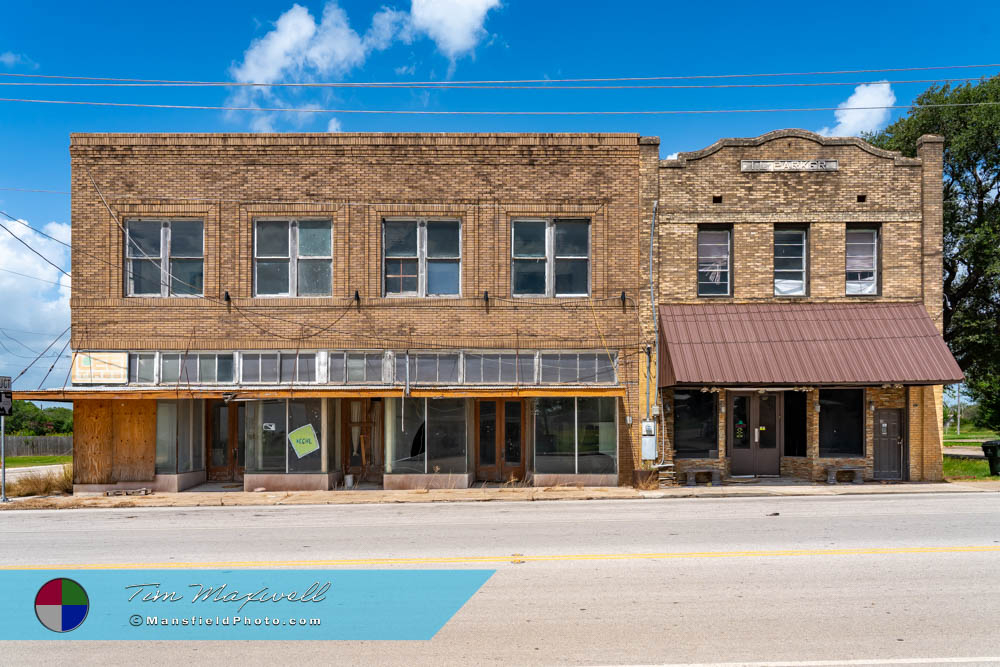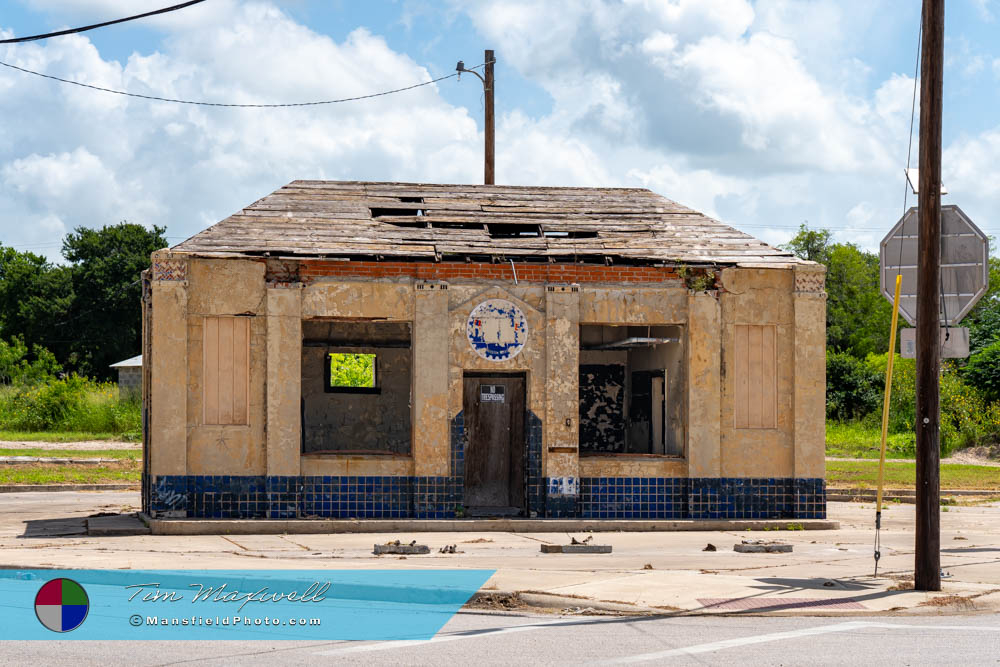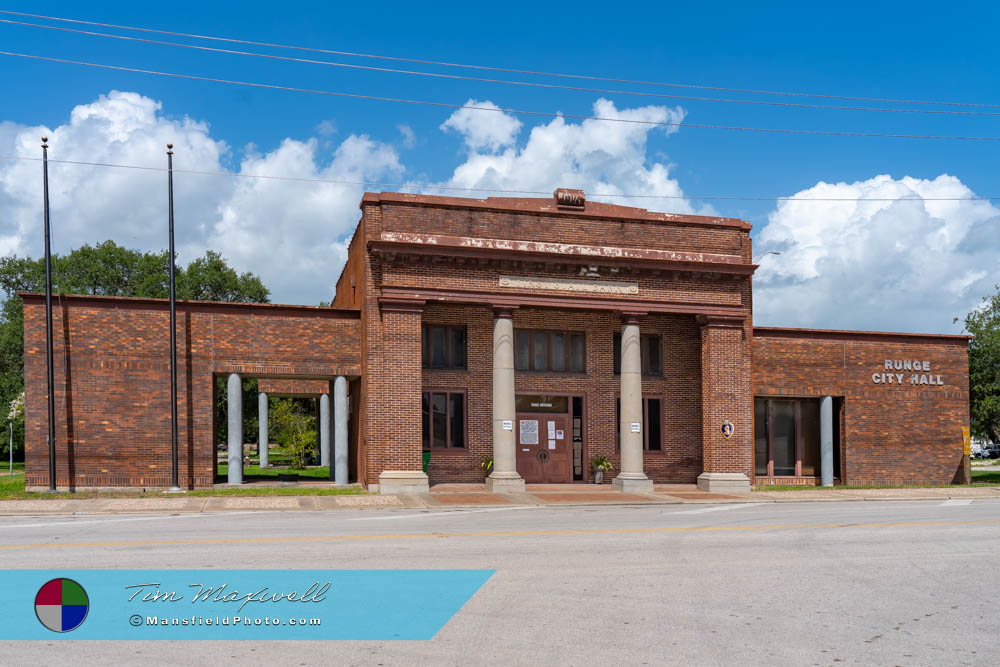Mansfield Photography
Runge, Texas
– The Past Whispers Through Empty Storefronts.
Runge, Texas, sits at the crossroads of State Highway 72 and a web of farm roads, just west of the DeWitt County line. It may appear quiet at first glance, with its largely unused downtown buildings and a feeling that leans toward ghost town, but on closer inspection, life still flows through this small community. On a recent visit, traffic moved steadily past old brick structures thanks to a busy gas station and a handful of eateries drawing in passersby. Though the town has slowed, it hasn’t stopped.
From Sulphur Springs to Something New
The area now called Runge developed in 1887 near older communities known as Sulphur Spring, Mineral Spring, and Hortonville. It was named for Henry Runge, a German immigrant who became a pioneer merchant and banker. His company, H. Runge and Company, played a central role in developing the town. When Gustav Tips arrived to open a store for the firm, he found only a single house and a dirt street—but that quickly changed.
By the time the post office opened in 1887, the town was on the rise. Just three years later, it had become the largest town in Karnes County. Its early growth was rapid and impressive. With a mercantile store, depot, lumberyard, gin, saloon, and more, it was a true center of commerce in southeastern Karnes County.
A Center for Education and Community Life
Education was a key focus during Runge’s early days. The town had a two-story school building by 1892, costing $5,000—a considerable sum at the time. By 1902, over 300 students were enrolled.
As was common in Texas then, schools were segregated by race and ethnicity. A small rented house served as the school for Mexican-American children in 1901, and separate buildings existed for Black and white students. Integration didn’t occur until the 1950s.
Despite challenges, the town prioritized education and civic development. A new school for white students was built in 1917 but tragically burned in 1930. A more modern replacement opened later that year. The Mexican-American school was rebuilt in 1931. These efforts reflected a town striving to improve opportunity for future generations—even amid segregation-era policies.
Civic Pride and a Devastating Tornado
Community spirit took many forms in Runge. The public square once held a prominent bandstand, originally built in the 1890s and rebuilt in 1924. A local orchestra played for events and holidays, and social groups like the Masonic lodge created a sense of cohesion among residents. The lodge, chartered in 1897, would later merge with Kenedy’s chapter in 1982.
But not all was festive. On May 6, 1930, a F4 tornado devastated the southern part of town, killing twenty-seven and injuring thirty-four. It was one of the darkest days in the community’s history. Despite the tragedy, Runge pushed forward, constructing a two-story city hall, fire station, and auditorium the following year.
The Influence of Gus Tips
A major force behind much of the town’s early development was Gustav Tips. He arrived in 1887 and remained one of the most active and influential citizens. After founding a store with a business partner, Tips expanded into banking and cotton ginning. He helped establish two banks and served as the first mayor following incorporation in 1912. Prior to that, the Runge Town Company, with Tips as agent, handled local affairs. His involvement shaped the town’s growth for decades.
Ghost Town Vibes, With a Pulse
Today, many of the historic buildings that once housed barbershops, saloons, and stores are shuttered. Weathered façades and vacant windows offer a visual contrast to the flow of life happening around them. Though downtown might feel like a ghost town, the steady hum of cars and the activity around a busy gas station prove otherwise. Locals and travelers still pass through daily, keeping Runge on the map.
Then and Now
In the mid-1900s, the local economy depended on farming, dairying, ranching, and later, oil and gas. The population saw slow shifts—1,001 in 1940, 1,244 in 1980, and around 1,080 by 2000. While many small Texas towns have faded, this one holds steady, even as its storefronts remain mostly quiet.
The Runge Museum, opened in 1973 to honor the town’s past, was lost to fire in 1992. But history continues to echo in places like the bandstand, which still stands in the town square with a historical marker placed in 1970. Runge may not have the booming main street it once did, but its legacy is visible in its architecture, in the stories of people like Gus Tips, and in the resilience of its residents.
In a time when many small towns vanish without a trace, this one holds on. Faint traces of its heyday remain—but so does the life that moves around them.
📸 Interested in More Photos of This Town?








